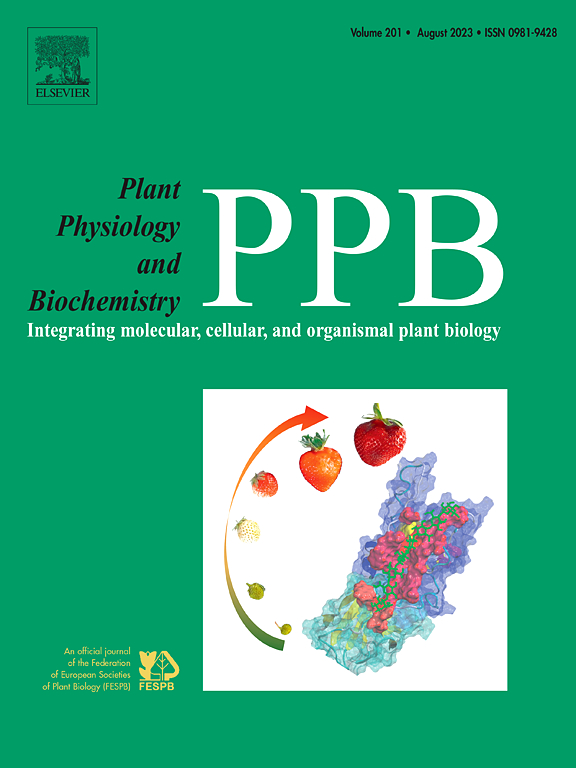The relationship between mitochondrial respiration metabolism, energy efficiency and ultraweak luminescence in strawberry fruit
IF 5.7
2区 生物学
Q1 PLANT SCIENCES
引用次数: 0
Abstract
Background
Ultraweak luminescence (UWL) is a natural phenomenon characterized by extremely low light emission in living organisms. Although it has attracted scientific attention for decades, its underlying mechanisms remain unclear.
Objective
This study aimed to elucidate the relationship between mitochondrial respiratory metabolism and UWL in strawberry fruit mitochondria, focusing on how electron transport and oxidative phosphorylation affect UWL intensity.
Methods
Mitochondria from the strawberry variety ‘Hongyan' were treated with activators adenosine diphosphate (ADP) and sodium succinate (C4H4Na2O4) or inhibitors 2,4-Dinitrophenol (DNP) and sodium vanadate (NaVO4) during ATP synthesis. Comparative analyses assessed mitochondrial respiration, energy parameters, and UWL changes under these treatments.
Results
Activator treatments significantly increased respiratory enzyme activities of succinate dehydrogenase (SDH), cytochrome c oxidase (COX) and H+-ATPase, respiration rate, respiratory pathway contributions, ATP, ADP, energy charge, and UWL intensity at higher concentrations (P < 0.05). In contrast, inhibitor treatments caused progressive reductions in these indicators and UWL intensity, also reaching significance at higher concentrations. Correlation analysis showed UWL intensity was positively associated with respiration metrics, especially respiration rate and cytochrome pathway contribution (P < 0.05), and strongly correlated with ATP, ADP, and energy charge (P < 0.05 or P < 0.01), while negatively correlated with AMP (P < 0.05). Principal component analysis indicated that energy parameters contributed most to UWL variation, followed by respiration rate and enzyme activities.
Conclusion
UWL intensity reflects mitochondrial respiratory metabolism and ATP production, suggesting mitochondria are key organelles in UWL generation. UWL could serve as a potential indicator of mitochondrial function and cellular energy status.
草莓果实线粒体呼吸代谢、能量效率与超弱发光的关系
摘要超弱发光(UWL)是生物体内以极低的光发射为特征的一种自然现象。尽管它已经引起了几十年的科学关注,但其潜在机制仍不清楚。目的探讨草莓果实线粒体呼吸代谢与UWL的关系,重点研究电子传递和氧化磷酸化对UWL强度的影响。方法用激活剂二磷酸腺苷(ADP)和琥珀酸钠(C4H4Na2O4)或抑制剂2,4-二硝基酚(DNP)和钒酸钠(NaVO4)处理红岩草莓线粒体ATP合成。比较分析评估了这些处理下线粒体呼吸、能量参数和UWL的变化。结果激活剂处理显著提高了呼吸酶(SDH)、细胞色素c氧化酶(COX)和H+-ATP酶)活性、呼吸速率、呼吸途径贡献、ATP、ADP、能量电荷和UWL强度(P <;0.05)。相比之下,抑制剂处理导致这些指标和UWL强度的逐渐降低,在更高浓度下也达到显著性。相关分析显示,UWL强度与呼吸指标呈正相关,尤其是呼吸速率和细胞色素途径的贡献(P <;0.05),且与ATP、ADP和能量电荷密切相关(P <;0.05或P <;0.01),与AMP呈负相关(P <;0.05)。主成分分析表明,能量参数对水分流失的影响最大,其次是呼吸速率和酶活性。结论UWL强度反映了线粒体呼吸代谢和ATP的产生,表明线粒体是UWL产生的关键细胞器。UWL可以作为线粒体功能和细胞能量状态的潜在指标。
本文章由计算机程序翻译,如有差异,请以英文原文为准。
求助全文
约1分钟内获得全文
求助全文
来源期刊
CiteScore
11.10
自引率
3.10%
发文量
410
审稿时长
33 days
期刊介绍:
Plant Physiology and Biochemistry publishes original theoretical, experimental and technical contributions in the various fields of plant physiology (biochemistry, physiology, structure, genetics, plant-microbe interactions, etc.) at diverse levels of integration (molecular, subcellular, cellular, organ, whole plant, environmental). Opinions expressed in the journal are the sole responsibility of the authors and publication does not imply the editors'' agreement.
Manuscripts describing molecular-genetic and/or gene expression data that are not integrated with biochemical analysis and/or actual measurements of plant physiological processes are not suitable for PPB. Also "Omics" studies (transcriptomics, proteomics, metabolomics, etc.) reporting descriptive analysis without an element of functional validation assays, will not be considered. Similarly, applied agronomic or phytochemical studies that generate no new, fundamental insights in plant physiological and/or biochemical processes are not suitable for publication in PPB.
Plant Physiology and Biochemistry publishes several types of articles: Reviews, Papers and Short Papers. Articles for Reviews are either invited by the editor or proposed by the authors for the editor''s prior agreement. Reviews should not exceed 40 typewritten pages and Short Papers no more than approximately 8 typewritten pages. The fundamental character of Plant Physiology and Biochemistry remains that of a journal for original results.

 求助内容:
求助内容: 应助结果提醒方式:
应助结果提醒方式:


